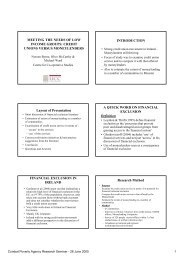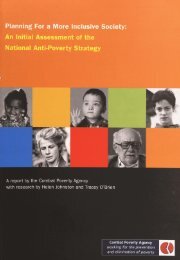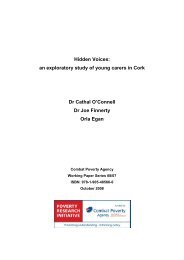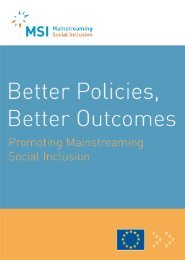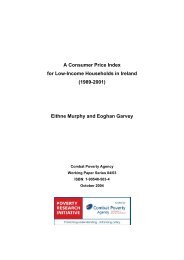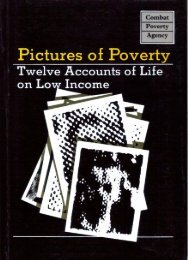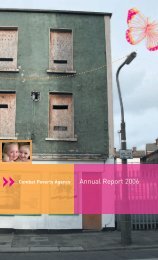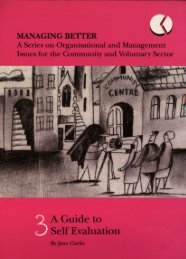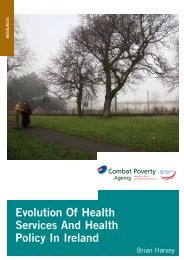The Distribution of Income in Ireland (2000) - Combat Poverty Agency
The Distribution of Income in Ireland (2000) - Combat Poverty Agency
The Distribution of Income in Ireland (2000) - Combat Poverty Agency
- No tags were found...
You also want an ePaper? Increase the reach of your titles
YUMPU automatically turns print PDFs into web optimized ePapers that Google loves.
34 <strong>The</strong> <strong>Distribution</strong> <strong>of</strong> <strong>Income</strong> <strong>in</strong> <strong>Ireland</strong><strong>The</strong> shape <strong>of</strong> the disposable <strong>in</strong>come distribution after adjustmentfor differences <strong>in</strong> household size and composition,us<strong>in</strong>g alternative equivalence scales, was seen to have changed<strong>in</strong> a similar way to the unadjusted distribution between 1994and 1997. Focus<strong>in</strong>g on the distribution among persons ratherthan households showed a decl<strong>in</strong>e <strong>in</strong> shares for the bottom butnow little change at the top.A decomposition analysis <strong>of</strong> the distribution <strong>of</strong> equivalised<strong>in</strong>come <strong>in</strong> 1994 and 1997 looked at <strong>in</strong>equality with<strong>in</strong> and betweendifferent groups <strong>of</strong> households, dist<strong>in</strong>guished on the basis<strong>of</strong> age, gender, labour force status and social welfare dependence.For example, this showed that <strong>in</strong>equality betweenhouseholds categorised by the labour force status <strong>of</strong> the headaccounted for about 27 per cent <strong>of</strong> overall <strong>in</strong>equality <strong>in</strong> 1994and 24 per cent <strong>in</strong> 1997. With<strong>in</strong> these groups, <strong>in</strong>equality washighest for households headed by a self-employed person andlowest among the retired.<strong>The</strong>re were also some changes <strong>in</strong> the location <strong>of</strong> differenttypes <strong>of</strong> household <strong>in</strong> the <strong>in</strong>come distribution. Those <strong>in</strong> householdsheaded by someone aged between 35 and 64 werespread rather evenly over the qu<strong>in</strong>tiles <strong>in</strong> both 1994 and 1997,but there were considerable shifts for both older and youngerhouseholds. In particular, households headed by someoneaged 65 or over were more heavily concentrated towards thebottom by 1997.Initial results from the 1998 Liv<strong>in</strong>g <strong>in</strong> <strong>Ireland</strong> survey showeda cont<strong>in</strong>ued decl<strong>in</strong>e <strong>in</strong> the share <strong>of</strong> equivalised <strong>in</strong>come go<strong>in</strong>g tothe bottom 30 per cent <strong>of</strong> households. This brought the cumulativefall <strong>in</strong> the share <strong>of</strong> the bottom 30 per cent from 1994 to 1998up to 1.4 per cent <strong>of</strong> total <strong>in</strong>come. A decl<strong>in</strong><strong>in</strong>g share for the topdecile from 1994 to 1997 had <strong>of</strong>fset this decl<strong>in</strong>e <strong>in</strong> terms <strong>of</strong>overall <strong>in</strong>equality, but from 1997 to 1998 the share <strong>of</strong> that decilerose and so did summary <strong>in</strong>equality measures.In assess<strong>in</strong>g both the overall shape <strong>of</strong> the distribution <strong>of</strong> <strong>in</strong>come<strong>in</strong> <strong>Ireland</strong> and these recent trends, a frame <strong>of</strong> reference isprovided by comparison with correspond<strong>in</strong>g figures for othercountries. That is the topic <strong>of</strong> Chapter 5, but first we look <strong>in</strong>Chapter 4 at how the Irish distribution has been evolv<strong>in</strong>g over alonger period, back to the early 1970s.Chapter 4Trends <strong>in</strong> the Irish <strong>Income</strong><strong>Distribution</strong> S<strong>in</strong>ce 1973Brian Nolan4.1 INTRODUCTIONSo far we have focused on data from the household surveys carriedout by the ESRI <strong>in</strong> the 1990s. In this chapter we use datafrom a household survey carried out by the ESRI <strong>in</strong> 1987, andfrom the Household Budget Surveys carried out by the CSO <strong>in</strong>1973, 1980, 1987 and 1994/95, to see how the Irish <strong>in</strong>come distributionhas been evolv<strong>in</strong>g over a longer period. Section 4.2looks at 1987 and 1994, for which estimates <strong>of</strong> the <strong>in</strong>come distributionare available from both ESRI and HBS surveys. Section4.3 documents trends <strong>in</strong> the distribution over the period from1973 to 1997. Section 4.4 analyses factors underp<strong>in</strong>n<strong>in</strong>g theselonger-term trends, while Section 4.5 presents an <strong>in</strong>-depth decompositionanalysis <strong>of</strong> the 1987-1994 changes. Section 4.6summarises the ma<strong>in</strong> f<strong>in</strong>d<strong>in</strong>gs.4.2 THE INCOME DISTRIBUTION IN 1987 AND 1994We look first at the distribution <strong>of</strong> disposable <strong>in</strong>come amonghouseholds <strong>in</strong> the ESRI and CSO samples for 1987 and 1994, <strong>in</strong>Table 4.1. (We concentrate now on the distribution amonghouseholds rather than persons, because it is only on that basisthat we can push the comparisons back to 1973 <strong>in</strong> the next section.)We see that <strong>in</strong> each <strong>of</strong> the years there was some differencebetween the estimates derived from the ESRI surveys and




